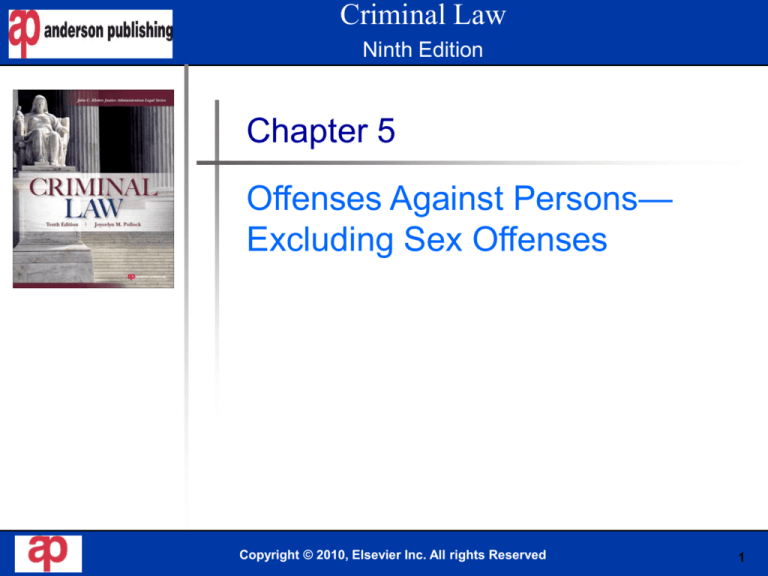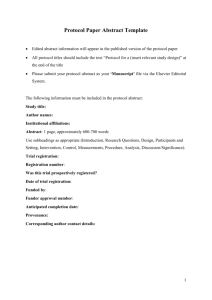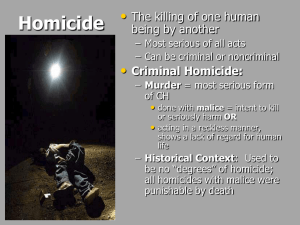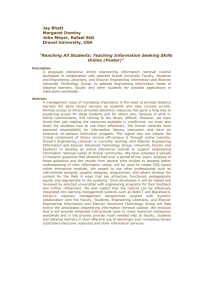
Criminal Law
Ninth Edition
Book
Cover
Here
Chapter 5
Offenses Against Persons—
Excluding Sex Offenses
Copyright © 2010, Elsevier Inc. All rights Reserved
1
5.2
Homicide
Common Law
In early common law, an intentional killing was
homicide.
In later years, homicide was generally defined as the
unlawful killing of a human being by another human
being.
Copyright © 2010, Elsevier Inc. All rights Reserved
2
5.2
Homicide
Common Law
Year-and-a-day rule
State v. Orrell (1826)
If death did not take place within a year and a day of the time
of receiving the wound, the law draws the conclusion that it
was not the cause of death; and neither the court nor jury can
draw a contrary one.
In order to be murder, the killing had to be done with
malice aforethought.
Malice aforethought is a predetermination to commit an act
without legal justification or excuse.
Copyright © 2010, Elsevier Inc. All rights Reserved
3
5.2
Homicide
Model Penal Code
A person is guilty of homicide if he purposely,
knowingly, recklessly, or negligently causes the death
of another human being.
Criminal homicide is murder, manslaughter, or
negligent homicide.
Copyright © 2010, Elsevier Inc. All rights Reserved
4
5.2
Homicide
State Statutes, Codes, and Cases
Wording of the Model Penal Code.
Retained the distinction between first and second
degrees of murder.
Other states have divided manslaughter into degrees.
The actus reus of homicide is always an act that
results in the death of another.
The mens rea determines the type of homicide.
Copyright © 2010, Elsevier Inc. All rights Reserved
5
5.2
Homicide
Actus Reus: (Causation: Year-and-a-Day Rule)
Advancements in medical science have necessitated
modifications.
State v. Hefler
Concluded that the law was an anachronism
Rogers v. Tennessee
Victim died of kidney infection 15 months after the defendant
stabbed the man in the heart.
The Supreme Court upheld the Tennessee court decision that
affirmed his conviction and held that it was not a violation of
due process because it was not unexpected that the rule
would be abandoned.
Copyright © 2010, Elsevier Inc. All rights Reserved
6
5.2
Homicide
Actus Reus: Defining Death
Under common law, death was defined as the
cessation of respiratory functions.
Brain-death statutes have been implemented to
determine when a person is dead.
The Uniform Determination of Death Act (1980)
Codifies the existing common law basis of determining
death—total failure of the cardiorespiratory system—and
extends the common law determination of death to include
irreversible loss of all brain function.
Copyright © 2010, Elsevier Inc. All rights Reserved
7
5.2
Homicide
Actus Reus: Defining Death
A Washington court held that it is for the law, rather
than medicine, to define the standard of death.
In re Welfare of Bowman
Irreversible cessation of circulation and respiratory functions,
or
Irreversible cessation of all functions of the entire brain,
including the brain stem, is “dead.”
Copyright © 2010, Elsevier Inc. All rights Reserved
8
5.2
Homicide
Terry Schiavo Case
Schiavo was diagnosed as being in a permanent
vegetative state and had been for 15 years.
She was not “brain dead” according to the definitions.
Her husband and her doctors had the legal authority
to remove her feeding tubes.
Parents did not want them removed.
Without statutory authority, removing feeding tubes
from someone in a vegetative state may be murder.
Copyright © 2010, Elsevier Inc. All rights Reserved
9
5.2
Homicide
Exception to Double Jeopardy
What happens if a victim dies as a result of an assault
after the perpetrator has already been charged and
convicted of a lesser crime?
In an exception to double jeopardy recognized by some
states, a second prosecution may commence because of a
finding that the more serious crime of homicide includes
additional elements to the lesser crime of assault.
New York v. Latham
Pled guilty to attempted murder in the second degree.
Victim later died and the defendant was retried and convicted of
depraved indifference murder.
Copyright © 2010, Elsevier Inc. All rights Reserved
10
5.3
Murder
Common Law
Murder is defined as a homicide committed with
malice aforethought.
Elements of murder
Unlawful killing
A human being
By another human being
With malice aforethought
Felony-murder
Copyright © 2010, Elsevier Inc. All rights Reserved
11
5.3
Murder
Unlawful Killing
A killing is unlawful unless it comes under the
justifiable homicide or excusable category.
Excusable homicide is committed by one doing a
lawful act without intention to hurt, or in self-defense.
Copyright © 2010, Elsevier Inc. All rights Reserved
12
5.3
Murder
A Human Being
In the absence of a statute, a person cannot be
convicted of murder unless the person whose death
occurred was born alive.
Almost half of the states have amended their statutes
to define murder as the “unlawful killing of a human
being, or a fetus…” or created a new feticide statute
to cover the killing of an unborn.
Feticide is the destruction of the fetus; the act by which
criminal abortion is produced.
Copyright © 2010, Elsevier Inc. All rights Reserved
13
5.3
Murder
By Another Human Being
Proof that the killing was committed by another human
being requires that evidence be produced to show that
the person accused committed the act or put into
motion the means that resulted in the death.
Copyright © 2010, Elsevier Inc. All rights Reserved
14
5.3
Murder
With Malice Aforethought
Early common law required at least an attempt to kill,
plus an element of hatred, spite, or ill-will, in order to
bring the killing within the malice definition.
Judges required that the prosecution prove that the
defendant actually had a previously thought-out intent
to kill.
Later the courts realized that murder may be
committed under some circumstances without the
intent to kill.
Copyright © 2010, Elsevier Inc. All rights Reserved
15
5.3
Murder
Felony-Murder
Felony-murder doctrine
Under early English law, one who, in the commission or
attempted commission of any felony, caused another’s
death, could be found guilty of murder.
Copyright © 2010, Elsevier Inc. All rights Reserved
16
5.3
Murder
Model Penal Code
Not differentiated into first and second degree.
A person may be found guilty of murder if the killing
was done purposely or knowingly.
Criminal homicide also constitutes murder when it is
“committed recklessly under circumstances
manifesting extreme indifference to the value of
human life.”
Copyright © 2010, Elsevier Inc. All rights Reserved
17
5.3
Murder
State Statutes, Codes, and Cases
Some states have modified the common law relating
to murder, others have adopted the Model Penal
Code in substance, while still others have taken parts
of the Model Penal Code and retained parts of their
previously written statutes.
Some states include provisions that retain the felonymurder doctrine.
Copyright © 2010, Elsevier Inc. All rights Reserved
18
5.3
Murder
First-Degree Murder
Intent to commit murder, accompanied by
premeditation and deliberation.
Premeditation means that one in fact did reflect, at
least for a short period, before the act of killing.
Second-Degree Murder
If premeditation or intent cannot be proven.
Copyright © 2010, Elsevier Inc. All rights Reserved
19
5.3
Murder
Depraved Indifference Murder
When an offender does an act that shows a complete
disregard for human life and there is a probable
certainty of injury, that offender may be found guilty of
depraved heart murder even if they had no intent to
kill.
Transferred Intent
The doctrine of transferred intent holds an offender
responsible even when the end result is not what was
intended.
Copyright © 2010, Elsevier Inc. All rights Reserved
20
5.3
Murder
Felony-Murder
Common law = occurred during the course of a felony
Model Penal Code = limited to specific felonies
State statutes = also restricted to only certain felonies
Copyright © 2010, Elsevier Inc. All rights Reserved
21
5.3
Murder
Summary
Murder is often divided into first- and second-degree
in modern statutes.
The difference between the two levels of murder is
based on the mens rea.
The degree of murder will affect the level of
punishment.
Copyright © 2010, Elsevier Inc. All rights Reserved
22
5.3
Murder
First-Degree Murder
A/R
M/R
Unlawful killing of one by another human
Intentional, premeditated
Second-Degree Murder
A/R
Unlawful killing of one by another human
M/R
Without premeditation or with callous disregard or wanton
disregard or depraved indifference
Copyright © 2010, Elsevier Inc. All rights Reserved
23
5.3
Murder
Felony-Murder
A/R
Unlawful killing or foreseeable death + A/R of underlying
felony
M/R
Intentional (of the underlying felony) + (in some states)
callous disregard
Copyright © 2010, Elsevier Inc. All rights Reserved
24
5.4
Voluntary Manslaughter
Common Law
Voluntary manslaughter is the intentional killing of one
human being by another without justification or
excuse, but committed under the influence of passion
induced by great provocation.
The following conditions must exist:
There must have been adequate provocation,
The killing must have been in the heat of passion,
It must have been a sudden passion, and
There must have been a causal connection between the
provocation, the passion, and the fatal act.
Copyright © 2010, Elsevier Inc. All rights Reserved
25
5.4
Voluntary Manslaughter
Model Penal Code
Does not distinguish between voluntary and
involuntary manslaughter.
Criminal homicide constitutes manslaughter when
It is committed recklessly; or
A homicide which would otherwise be murder is committed
under the influence of extreme mental or emotional influence
for which there is reasonable explanation or excuse.
Copyright © 2010, Elsevier Inc. All rights Reserved
26
5.4
Voluntary Manslaughter
State Statutes, Codes, and Cases
Two of the elements are exactly the same as those of
murder:
An unlawful killing
One person by another
Most distinguishable element is the sudden passion
aroused by extreme provocation.
Copyright © 2010, Elsevier Inc. All rights Reserved
27
5.4
Voluntary Manslaughter
Provocation
Must be of such a nature as to be recognized at law
as adequate for that purpose.
Heat of Passion
The emotional state must have dominated the slayer
at the time of the homicidal act, and it must have been
entertained toward the person slain, and not to
another person.
Copyright © 2010, Elsevier Inc. All rights Reserved
28
5.4
Voluntary Manslaughter
No “Cooling-Off”
If it appears that the defendant reflected, deliberated,
or cooled off for any period before the fatal act, the
killing is murder.
What constitutes “cooling-off time” depends upon the
nature and circumstances of provocation, the extent to
which the passion has been aroused, and the nature
of the act causing the provocation.
Copyright © 2010, Elsevier Inc. All rights Reserved
29
5.4
Voluntary Manslaughter
A Causal Connection
The heat of passion resulted from justifiable
provocation and that the heat of passion caused the
act that resulted in death.
There must be a causal link between the provocation,
the passion, and the act.
Burden of Proof
Once a defendant places provocation and passion in
issue, the state then bears the burden of negating the
presence of sudden heat beyond a reasonable doubt.
Copyright © 2010, Elsevier Inc. All rights Reserved
30
5.4
Voluntary Manslaughter
Voluntary Manslaughter
A/R
M/R
Unlawful killing of one by another human
Intentional, knowing but without “malice”—may be defined as
“without premeditation”
(Attendant circumstances)—provocation sufficient to
incite a reasonable person to passion that undermines
reason with no cooling-off period, and death was the
direct cause of provocation.
Copyright © 2010, Elsevier Inc. All rights Reserved
31
Two kinds
5.5
Involuntary Manslaughter
The killing occurs in the course of committing an
unlawful act, or
Death occurs during the negligent commission or
omission of an otherwise lawful act.
Elements
An unlawful killing of one person by another,
Unintentional but:
During commission of a lawful act performed with gross
negligence, or
Failure to perform a duty, or
During the commission of a crime not a felony.
Copyright © 2010, Elsevier Inc. All rights Reserved
32
5.5
Involuntary Manslaughter
Model Penal Code
Has no section on involuntary manslaughter.
Has a provision regarding negligent homicide.
Negligent homicide
Criminal homicide constitutes negligent homicide when it is
committed negligently.
Requires proof of substantial fault and limits penal sanctions
to cases in which there are gross deviations from ordinary
standards of conduct.
Copyright © 2010, Elsevier Inc. All rights Reserved
33
5.5
Involuntary Manslaughter
State Statutes, Codes, and Cases
Some states follow the Model Penal Code.
Other jurisdictions retain the common law involuntary
manslaughter rule.
Others have added special statutes.
Copyright © 2010, Elsevier Inc. All rights Reserved
34
Involuntary Manslaughter
A/R
Killing of one by another human while doing an unlawful act
or a lawful act in a criminally negligent or reckless manner.
M/R
5.5
Involuntary Manslaughter
Reckless, negligent
Misdemeanor Manslaughter
A/R
Killing during the commission of a non-inherently dangerous
felony or misdemeanor
M/R
The mens rea required for the underlying crime
Copyright © 2010, Elsevier Inc. All rights Reserved
35
5.5
Involuntary Manslaughter
Negligent Homicide (MPC)
A/R
Unlawful killing of one by another human being while doing
an act in a criminally negligent manner
M/R
Criminal negligence
Copyright © 2010, Elsevier Inc. All rights Reserved
36
5.6
Suicide and Assisted Suicide
Common Law
Suicide is defined as intentional self-destruction.
At common law suicide was a felony and was know as
felo de se or felon of oneself.
Suicide was punished by an ignominious burial and the
forfeiture of goods and chattels to the king.
If two persons mutually agreed to commit suicide, and one
survived the survivor was guilty of the murder of the one who
died.
Copyright © 2010, Elsevier Inc. All rights Reserved
37
5.6
Suicide and Assisted Suicide
Model Penal Code
Does not define suicide as a crime.
There is a crime of solicited or assisted suicide.
Causing Suicide as Criminal Homicide
A person may be convicted of criminal homicide for causing
another to commit suicide only if he purposely causes such
suicide by force, duress, or deception.
Aiding or Soliciting Suicide as an Independent
Offense
A person who purposely aids or solicits another to commit
suicide if guilty of a felony of the second degree if his conduct
causes such suicide or an attempted suicide.
Copyright © 2010, Elsevier Inc. All rights Reserved
38
5.6
Suicide and Assisted Suicide
State Statutes, Codes, and Cases
The majority of states do not criminalize suicide.
In most states it is a crime to help another commit or
attempt suicide.
Dr. Jack Kevorkian
Washington v. Glucksberg
Vacco v. Quill
Prohibition against causing or aiding suicide does not violate the due
process clause.
There is a clear line between assisting suicide and withdrawal or
permitting the refusal of unwanted lifesaving medical treatment.
Gonzales v. Oregon
The federal government sought a ruling that the physician’s
prescription of drugs to end one’s life was not a legitimate medical use.
Copyright © 2010, Elsevier Inc. All rights Reserved
39
5.6
Suicide and Assisted Suicide
Although there are no current statutes or case
law that criminalize suicide, most states do have
laws that prohibit one party from assisting
another in committing suicide and the Supreme
Court has upheld such laws, finding that there is
no constitutional right to die.
Since Gonzales v. Oregon, however, the door is
open for states to pass their own laws that allow
for assisted suicide by physicians in certain
limited circumstances when a patient is
terminally ill.
Copyright © 2010, Elsevier Inc. All rights Reserved
40
5.6
Suicide and Assisted Suicide
Assisting Suicide
A/R
Cause (through duress or force), solicit, assist, aid, advise
suicide of another
M/R
Purposeful
Copyright © 2010, Elsevier Inc. All rights Reserved
41
5.7
Assault and Battery
Common Law
Assault and battery were two separate crimes.
An assault was any unlawful offer or attempt to injure
another, with an apparent present ability to effectuate
the attempt under circumstances creating a fear of
imminent peril.
A specific intent crime
Battery was the unlawful touching of the person of
another by the aggressor or by some substance put in
motion by him.
A general intent crime
Copyright © 2010, Elsevier Inc. All rights Reserved
42
5.7
Assault and Battery
Model Penal Code
Simple Assault
Attempts to cause or purposely, knowingly, or recklessly
causes bodily injury to another; or
Negligently causes bodily injury to another with a deadly
weapon; or
Attempts by physical menace to put another in fear of
imminent serious bodily harm.
Aggravated Assault
Attempts to cause serious bodily injury to another, or causes
such injury purposely, knowingly, or recklessly under
circumstances manifesting extreme indifference to the value
of human life; or
Attempt to cause or purposely or knowingly causes bodily
injury to another with a deadly weapon.
Copyright © 2010, Elsevier Inc. All rights Reserved
43
5.7
Assault and Battery
State Statutes, Codes, and Cases
Elements of Assault
Attempt or offer. The force intended to be applied must be put into
motion. Mere preparation does not amount to an assault; there must
be some act that could apparently produce injury.
The force or violence offered must be unlawful, but it may be in any
degree.
The attempt or offer must be directed toward another person. There
need not be any touching or striking of the person; but there must be
an offer to use force to injure another. The prosecution must show
that the person is placed in reasonable apprehension of receiving an
immediate battery; there must be a showing of force or menace of
violence that would be sufficient to put a person of reasonable
firmness in fear of immediate bodily harm.
Copyright © 2010, Elsevier Inc. All rights Reserved
44
5.7
Assault and Battery
State Statutes, Codes, and Cases
Elements of Assault
It is necessary is to show “apparent present ability” to effectuate the
harm. Assault does not occur unless the individual is placed in
reasonable fear of imminent bodily harm, but if the victim is placed in
reasonable fear of bodily harm, by conduct of the defendant, and the
defendant had the apparent ability to carry out the threatening
nature of his act, it is not necessary that the prosecution show that
the defendant had the actual ability to carry out the act.
An unlawful; application of force; to the person of another. The
application of force must be unlawful. The force may be direct or
indirect. The force must be to the person of another and be
unpermitted. But it is unnecessary that the victim’s body or even his
or her clothing be touched, because touching anything connected
with his or her person is sufficient.
Copyright © 2010, Elsevier Inc. All rights Reserved
45
5.7
Assault and Battery
Mayhem
Maliciously depriving another of the use of his limbs so as to
make him unable to defend himself against adversaries.
Copyright © 2010, Elsevier Inc. All rights Reserved
46
5.7
Assault and Battery
Assault
A/R
Attempt, threaten or offer, with unlawful force, to inflict
immediate bodily injury accompanied with apparent present
ability or offensive touching upon another
M/R
Purposely, knowingly, recklessly, or negligently (depending
on level or particular type of assault)
Copyright © 2010, Elsevier Inc. All rights Reserved
47
5.8
Kidnapping and Related Offenses
Common Law
Kidnapping was defined as the forcible abduction and
carrying away of a man, woman, or child from his or
her own country into another.
Traditional elements
Unlawful imprisonment
Moving him or her to another place
To unlawfully obtain ransom
Copyright © 2010, Elsevier Inc. All rights Reserved
48
5.8
Kidnapping and Related Offenses
Unlawful Imprisonment
Unlawfully restraining, unlawfully removing, or
unlawfully confining a person against their will.
Elements
Knowingly,
Unlawfully,
Restraining another, and
Under circumstances that expose the victim to a risk of
physical injury.
Copyright © 2010, Elsevier Inc. All rights Reserved
49
5.8
Kidnapping and Related Offenses
Model Penal Code
A person is guilty of kidnapping if he unlawfully
removes another from his place of residence or
business, or a substantial distance from the vicinity
where he is found, or if he unlawfully confines another
for a substantial period in a place of isolation, with any
of the following purposes:
To hold for ransom or reward, or as a shield or hostage; or
To facilitate commission of any felony or flight thereafter; or
To inflict bodily injury on or to terrorize the victim or another;
or
To interfere with the performance of any governmental or
political function.
Copyright © 2010, Elsevier Inc. All rights Reserved
50
5.8
Kidnapping and Related Offenses
State Statutes, Codes, and Cases
Traditional elements
Detaining another
By force or fraud
Without consent
Without legal cause
Asportation
For ransom or other unlawful purpose
Copyright © 2010, Elsevier Inc. All rights Reserved
51
5.8
Kidnapping and Related Offenses
Parental Kidnapping
Occurs when a parent who does not have legal
custody of a child refuses to return the child to the
custodial parent, and/or abducts the child.
Copyright © 2010, Elsevier Inc. All rights Reserved
52
5.8
Kidnapping and Related Offenses
Summary
Kidnapping has maintained the elements of common
law for the most part; however, case law has greatly
reduced the asportation requirement.
The common law requirement that the reason for the
kidnapping be for ransom or another unlawful purpose
has also been expanded, either by case law or
statute.
The most recent issue concerning the law of
kidnapping is how to deal with parental kidnappings,
especially those in which the parent has at least some
arguable noble purpose in protecting their child from
an abusive custodial parent.
Copyright © 2010, Elsevier Inc. All rights Reserved
53
5.8
Kidnapping and Related Offenses
Summary
States must honor the custodial orders of other states
and, therefore, parents must be deterred from taking
the law into their own hands by seizing the child.
Everyone can agree, however, that these cases are
different from kidnappings for ransom.
Copyright © 2010, Elsevier Inc. All rights Reserved
54
5.8
Kidnapping and Related Offenses
Kidnapping
A/R
Detaining another, with force or fraud, without consent,
asportation, for ransom or other unlawful purpose
M/R
Purposefully, knowingly
Copyright © 2010, Elsevier Inc. All rights Reserved
55
5.9
Hate Crimes (Bias Crimes)
Hate crime statutes are similar to traditional
criminal statutes prohibiting acts such as assault,
battery, or vandalism; however the hate crime
statutes require an additional element—that the
victim (or property) was selected as a target
because of the victim’s membership in a
protected group.
Copyright © 2010, Elsevier Inc. All rights Reserved
56
Two components
5.9
Hate Crimes (Bias Crimes)
Prohibited acts
Protected groups
Forty-nine states have adopted some form of
hate crime legislation.
Federal legislation has been enacted that
requires states to keep track of hate crime
statistics.
Copyright © 2010, Elsevier Inc. All rights Reserved
57
5.9
Hate Crimes (Bias Crimes)
Hate or Bias Crimes
A/R
Certain specified (illegal) acts, i.e., murder, assault,
vandalism, kidnapping; against specific victims (members of
protected groups)
M/R
Intentional
Copyright © 2010, Elsevier Inc. All rights Reserved
58





